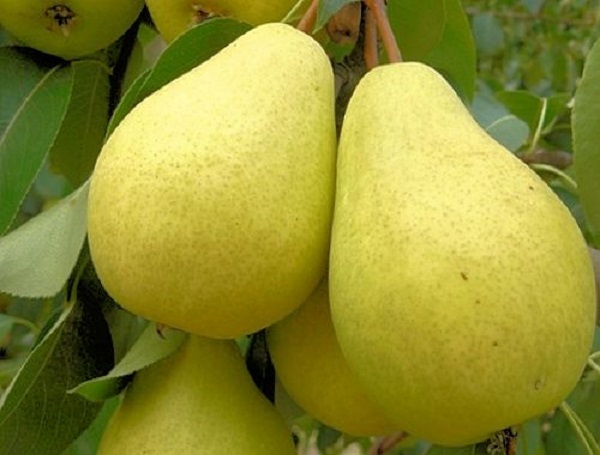Lada is a classic variety of pear, which is well acclimatized in any gardens in our country. Due to the huge number of positive qualities, this variety has won fame as the most popular pear.
Lada is recognized as a summer variety, the ripening period is in the middle of August. The average height of a pear is 2.5 m. The tree has a pronounced bob. The crown of his average density, up to three years, it is funnel, and at the onset of the period of fruiting becomes pyramidal.
Table of contents
Description and history of the appearance of varieties of pears Lada
Let's start with a description of the variety. The shoots of a pear are rather long, of medium thickness, slightly curved, in cross section - rounded, of a brown tint. Leaves are dark green in color, small in size. The length of the stem is 1.5–2.5 cm, the stipules fall off in the early stages.
Cupped flowers. There are 5–7 of them in each inflorescence. The fruits are not particularly large, weighing 100–110 g, obovate. Their surface is smooth and shiny. The ripened pear has a yellow color with a pinkish tinge on the sides.. Subcutaneous points are practically invisible. The peduncle of Lada is short, there is no funnel. The flesh is whitish yellow in color, grainy, medium density and not particularly juicy. The taste of the fruit is sour-sweet without a pronounced flavor.
Variety Lada brought academicians Chizhov and Potapov. This pear was the result of crossing Olga and Forest Beauty varieties. In 1993, the Lada pear variety was entered into the State Register in the Central, Central Black Earth and Middle Volga regions. The most famous Lada acquired in the Moscow region.
Advantages and disadvantages
Lada has many advantages, which include:
- skoroplodnost - pear for 2-4 years from the time of budding brings a full harvest;
- winter hardiness - even young trees that were planted in the fall are able to winter without shelter;
- high resistance to most diseases - Lada resistant to scab and bacterial burn.
Of the minuses of this variety note:
- short period of storage of fruits - only 55–65 days at a temperature of 0 ° C;
- low transportability - pears do not have good resistance to transportation.
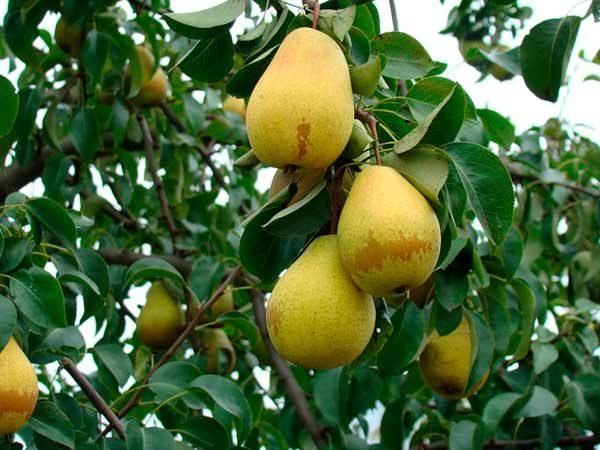
Landing
When planting seedlings of no small importance is the time of year. It is best to plant a pear in the spring. In the autumn, this should not be done, because of the likely weak formation of roots in the autumn-winter season.
Lada is not particularly demanding when choosing a soil, so it can grow almost anywhere. However, to increase the yield is better to use for planting soil with drainage or chernozem.
The selected area is pre-digged and fertilizers are applied: compost, potash salt and superphosphate.
Dimensions of the recess for the seedling should be larger than the rhizome, so that the tree is freely located during planting. In most cases, the depth is 70 cm and the diameter is 100 cm.
When immersed, the plants in the pit control that the root collar must look out for 5-7 cm, and the roots gently straighten and sprinkle with the soil where the seedling is grown. At the last stage of planting, the soil near the pear is well compacted and watered, and a small amount of manure or humus is poured around the plant. At the end of all the actions, the tree trunk is carefully tied to the dug cola.
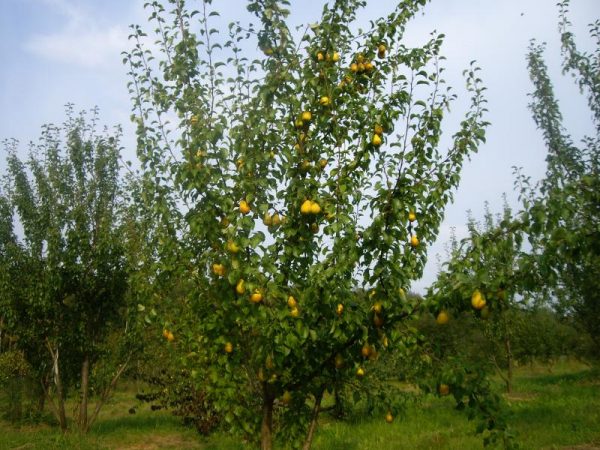
Care
The pear is often watered only during periods of prolonged drought, because very frequent irrigation damages the root system and provokes all sorts of diseases of this variety. The plant may even die completely due to an overabundance of moisture. Watering is carried out abundantly, 2-3 buckets of water under one tree. Also, pear moisture is needed in early summer, when fruits are poured.
In early spring, the tree is fed with nitrogen fertilizers. This is done when the snow melts and dry weather sets.
Dried and damaged branches that appear after the winter time, cut off. The stem of a tree trunk is usually treated with red lead or lime.
In the autumn, mineral fertilizers are used. They are added in October. In winter, the pear also needs proper care. It is necessary to ensure that when warming sleet does not stick to the branches of the tree. The weight of the snow layer can easily break thin branches. Stamps are not covered, because the pear has a high frost resistance.
Pruning pears Lada carried out twice a year: in spring and autumn. Unnecessary twigs are cut, very long ones make shorter pruners with a sharp sheath so as not to cause a lot of damage to the fruit plant. Then the cut sites are treated with garden putty.
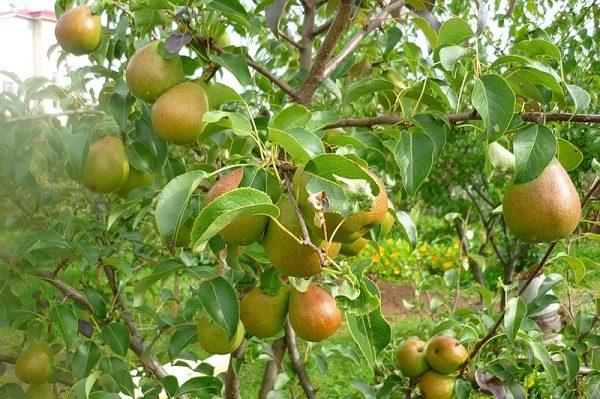
Terms of ripening and harvesting
Lada is a skoropplodny grade of the early period of maturing. With proper care and regular pruning, fruits appear for 3-4 years after planting. The first pears are harvested in early August, and the main harvest comes in the second half of this month. An adult tree brings about 50 kg of fruit annually.
Pears are firmly attached to the stem and fall off only when fully ripe. Due to this, it is possible to harvest in mid-September, when the pear fruit will become amber-golden color and make a blush.
The storage conditions for pears are as follows: a darkened room, a positive temperature of 1–4 ° C, humidity - not less than 85% and good ventilation. Fruits neatly placed in plastic boxes or wooden boxes. Spread the fruit in the selected container layers, which are separated with thin clean paper or dry straw. Do not create more than two layers.
Fruits of Lada pears are stored for 2–2.5 months. In addition, pears can be kept in the sand. When laying in wooden boxes, layers of fruit are sprinkled with sand. Thus, the fruits will be able to hold out until November.
Special features
- Lada is considered a self-fertile variety;
- fruits smaller than medium size;
- This pear has high and regular fruiting.
- fruits sufficiently long hang on the tree, and not showered.
Protection of an adult tree from diseases and pests
Lada has good resistance to scab and bacterial burn. But it is impossible to exclude the probability of infection with these diseases, as well as other diseases and insect pests.
Pest control begin before the period of sap flow. To do this, in one bucket of water 700 g of urea is dissolved and the stem and ground are treated around the pear.
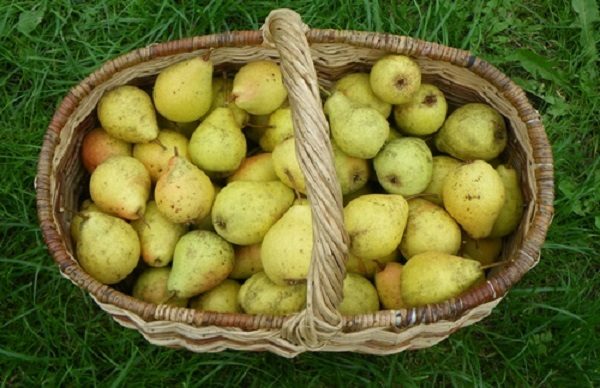
This event destroys all the pests that successfully survived the winter cold and frost on the plant.
But if you treat the pear with this solution later, then the swelling kidneys will burn.
To avoid diseases such as scab, bacterial burn, fruit rot, powdery mildew and rust should follow certain rules namely:
- Spray the tree three times in the period from the start of bud breakage to the ripening of all fruits, regardless of the presence of the disease.
- Remove dead leaves in time and remove weeds.
- Do not allow increased aridity or excessive moisture content in the soil.
The pests of this variety are: gall mite, pear sucker, aphid, moth and tstern beetle.
Basic measures for pest control:
- The most effective here are the planned processing of special solutions against parasites.
- Destruction of weeds is mandatory, as they are carriers of various pests.
- Regular and careful observation of the appearance of the trunk, branches and leaves on the pear.
Despite the fact that the variety was bred relatively recently, Lada has already become widespread in most Russian regions.
Such a popularity of this sort of pear contributes to its ability to take root in areas with low and changeable temperatures, unpretentiousness to care and significant yield indicators. Since Lada belongs to the early ripening varieties, it is not necessary to wait long for the moment to enjoy the tasty and juicy fruits.
